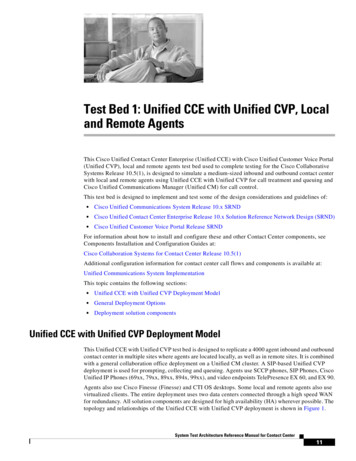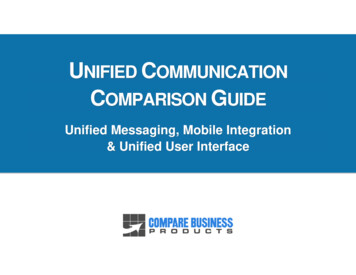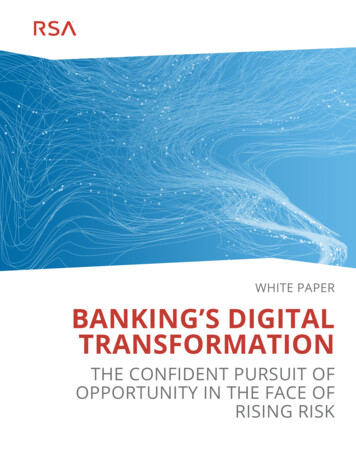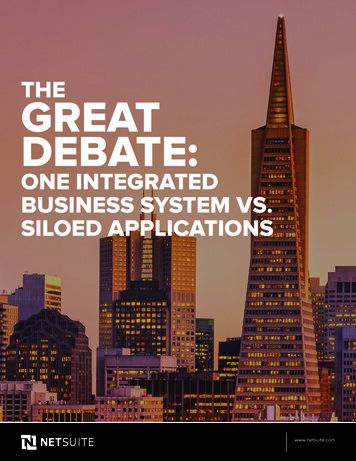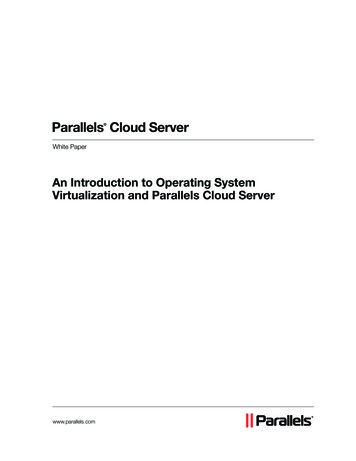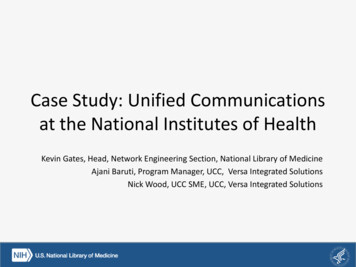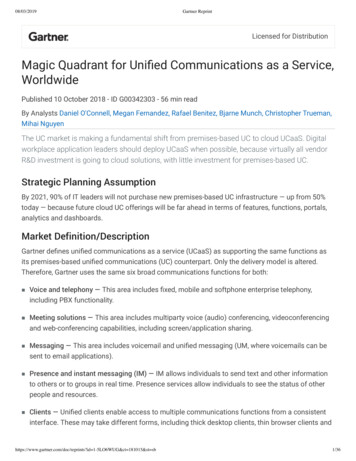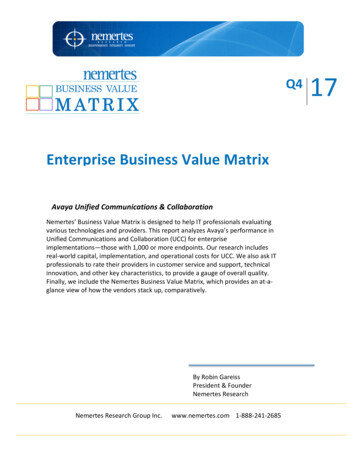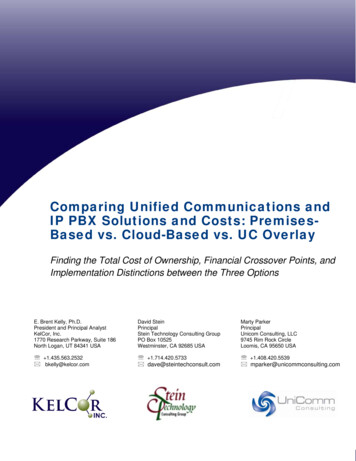
Transcription
white paperUnified Communications:The ‘Anywhere, Any Time’ Workplace
Unified Communications: The ‘Anywhere, Any Time’ WorkplaceXO CommunicationsTable of ContentsWorkers are Increasingly Mobile3The Mobile Workforce Uses Many Applications3IP—the Great Enabler of Unified Communications4The Cloud—the Great Enabler of Hosted “as a Service” Platforms4How UC Can Help: User Scenarios6Select UC Providers Carefully7Key UC Service Elements7Mobility Applications7Hosted IP-PBX8Enterprise SIP9Contact Center On-Demand9Why XO Communications for UC?10About XO Communications112
Unified Communications: The ‘Anywhere, Any Time’ WorkplaceXO CommunicationsThis paper explores the ways in which Unified Communications (UC) solutions can empowerworkers for greater productivity. For IT professionals, the paper examines concrete examplesof how UC can help the business, key UC applications, and how to select a UC provider thatenables you to get the most from UC tools for you and your workers.Workers are Increasingly MobileTake a look around your office. You’ll probably see evidence that your colleagues have gone“mobile.” Maybe your colleague’s desk is empty because she is working remotely or at a client’soffice. Perhaps you’re reading this paper as you travel to or from home. If so, your situationreflects a growing trend.As workers disperse to locations away from their offices, their need to engage and confer usingmobile devices to make time-sensitive decisions intensifies. These findings demonstrate the trendaccording to one recent study:1 78 percent of US employees use a mobile device for work, 65 percent of white-collar roles require phone mobility 44 percent of “knowledge workers” telecommute at least one day a week.Furthermore, a different study projects that the predominantly mobile portion of the workforce willmore than double in size in the years from 2013 through 2018.2Where you work has become less important. Working where you are has become more importantthan ever.The Mobile Workforce Uses Many ApplicationsThe overlap between work and home creates an increased familiarity and dependence ondifferent technologies and tools. Workers use applications at work, and they want the sameapplications at home, and vice versa. As a result, the communications devices we carry withus are exploding in number and variety. According to Cisco, knowledge workers will use anaverage of 3.3 devices in 2014.3 Workers are no longer tethered to their desks. They want to bringtheir office to their own phones and other devices and still be able to instantly collaborate withcoworkers.BYOD & Virtualization: Insights From the CISCO IBSG (Internet Business Solutions Group) Horizons Study, 5/12, p. 4Gartner Research, 2014 Top Ten Strategic Tech Trends, 10/9/133BYOD & Virtualization, ibid, p. 5123
Unified Communications: The ‘Anywhere, Any Time’ WorkplaceUCWhat Do We Mean ByUnifiedCommunications?Fundamentally, UC is a response to thegrowing realization that the companieswho can communicate informationfaster, easier, and most effectively willhave the competitive advantage.UC is not a single service, althoughthere are many disparate UC servicesin the marketplace. We define UCas a combination of several toolsthat collectively enable workers tocommunicate more efficiently acrossorganizations, work smarter, and drivedown costs.XO CommunicationsOne analyst report found the topdrivers that are pushing organizationsto adopt UC includes the demand for: Increased productivity Increased flexibility for employees Faster response time/delivery ofinformation4UC unites previously separate businesscommunications capabilities, suchas email, conferencing and video,to enhance worker productivity andbusiness processes and connectworkers, wherever they are.IP—the Great Enabler of Unified CommunicationsOur use of technology has evolved and reshaped our work environments in many ways, andUnified Communications is a direct result of these advancements. In the past, companies usedseparate dedicated networks to carry different types of communications. The telco PublicSwitched Telephone Network (PSTN) transported voice. Packet networks transported data. Andcable networks distributed video. Then Internet Protocol (IP) made it possible to carry all types ofmedia as data packets over an IP network.IP is now the central unifying force that made Unified Communications practical through its ability tocombine diverse methods of communication and transport them using only one networking protocol.The Cloud—the Great Enabler of Hosted “as a Service”PlatformsJust as IP has made it easier to transport different types of communications over one network,the growing use of the cloud has made it easier to deliver communications while reducingdependence on equipment. The cloud refers to software, platforms and infrastructure that are4IDG Enterprise, 2012 Unified Communications & Collaboration Survey, 3/124
Unified Communications: The ‘Anywhere, Any Time’ WorkplaceXO Communicationssold as a service, either remotely through the Internet or through a private IP connection. Thecloud has made it more efficient to access services from specialized service providers acrossa distance. In this scenario, companies pay only for the services they use, without upfrontcommitments or equipment costs. And in this way, IP and cloud technologies converged tobecome hosted communications solutions—solutions that offer all businesses a scalable andaffordable way to adopt Unified Communications.With IP and cloud use becoming more widespread, companies around the globe have been ableto use advanced technology to gain a competitive edge. This competitive pressure strengthensthe demands for greater efficiency, reduced costs, and above all, ever-increasing acceleration ofinformation transfer and communication.All businesses face pressures in this competitive environment and depend even more onrelationships with trusted, well-prepared, responsive communications service providers to helprespond rapidly and constructively to challenges.As shown in Figure 1, a recent report uncovered the three top employee “workplace” frustrationsacross all surveyed industries were the need to wait for information; the inability to locate andcontact people; and—email overload.5Figure 1: BroadSoft User Persona Research 2012—Top Communication FrustrastionsAnother study found that the average “knowledge worker” spent nearly a third of work time, or 73full work days a year, on email alone.6Unified Communications addresses all of these concerns, and more.5IDG Enterprise, 2012 Unified Communications & Collaboration Survey, 3/126Forbes, 2/19/14, “How Unified Communications Drive Productivity,” N. how-unified-communications-drive-productivity/5
Unified Communications: The ‘Anywhere, Any Time’ WorkplaceXO CommunicationsHow UC Can Help: User ScenariosA manager gets 15or more voice mailseach day. With herUC application, shecan readily displaythem on a screen,indexed like email,to see who themessages are fromand gauge theirurgency instead ofhaving to listen tothem in succession.Another workerdealing with a heavyinflux of email overa busy afternoonprefers to havehis emails readto him as voicemessages. Perhapshe is listening to hisemail messageswhile traveling orcommuting. Hecan select thisoption using a UCapplication.Two employees arecollaborating on aproject by phone.The first employeedescribes somethingto the other worker,but the secondworker admits hedoesn’t understandthe concept. Tohelp articulate theconcept visually, thefirst employee usesa UC tool to pull upand share a pictureon screen, while bothemployees are still onthe phone. This givesthe second employeewhat he needs tograsp the concept.An employee needsto quickly consultwith a much-indemand subjectmatter expert.Using UC tools, theemployee can scalethe expert’s wall ofmounting emails andovercome “telephonetag.” Instead, usinga combination ofcompany directoryand presenceapplications, itbecomes easy for theemployee to locatethe expert faster thanby phone or email,open and request aninstant message chat,and often get a quickanswer. The expertmay already be on thephone with someoneelse, but is able toexchange an IM torespond to a simplequestion—without thedelays of static modesof communication.A product manager isstill on a conferencecall when she needsto leave for anothermeeting or pick upa child from school.Without disrupting theconference, she canleave the office, stilllisten to the conferenceconversation on hermobile smartphone,and be able to pickthe child up ontime from school.A UC applicationenables seamlessand simultaneouscall transfer so thatthe product managercan multi-task andaccomplish workand home life needswithout disruption.These extra five, ten orfifteen minutes on thiscall could result in herbeing able to deal witha critical work issueand thereby avoidthe need for moremeetings. Conversely,some callers prefer toswitch mobile calls toland line phones oncein the office or at homefor more reliable callquality.6
Unified Communications: The ‘Anywhere, Any Time’ WorkplaceXO CommunicationsSelect UC Providers CarefullyUC is so vital to businesses that it’s important to select a trusted, quality communicationsservices provider to act as adviser and provide a complete, end-to-end UC solution.Look for a UC provider that can provide solutions with business-grade performance, customerservice and responsiveness. Some providers use the public Internet to host UC solutions butit has unreliable quality and security. Instead, seek a provider with its own high-quality, secure,IP data network with local, nationwide and international coverage. You’ll also want to select aprovider that provides transparent access to a web-based portal where your employees cancontrol their own UC preferences, yet IT administrations have control over overall companypolicies and settings. Tier One service level agreements are also a must for the best performance.All of this is possible—even at costs that beat the Internet-based UC companies.Key UC Service ElementsMobility ApplicationsKey UC mobility applications (XO calls theirs WorkTime) let workers virtually take their office withthem, anywhere, anytime. Workers can always put forth a professional appearance on businesscalls because the mobility app lets them use their business phone number on any BYOD wirelessphone. They can use different numbers for work and personal use or combine the two on onenumber.A mobility app is the glue that brings UC to mobile devices. It provides simultaneous ringacross desk phone, personal smart phone and/or home computer. Smart phone users who useWorkTime, for example, get IM, presence and videoconferencing along with free on-net, local andinbound calling and long-distance calling charged to the company plan. Each device license getsfive thousand free SMS text messages monthly. Business mobile cost reductions from using amobility app such as WorkTime typically average over 40 percent.User accessibility and ease of use are essential for UC to flourish. Employees should be ableto readily download the UC mobility app to their personal smartphone and computers. XO’sWorkTime is available with XO’s SIP, Hosted PBX and IP Flex for a modest per-person fee. Theapplication integrates these XO VoIP services with workers’ devices, using the network or WiFiconnection of the worker’s own phone, eliminating any need for separate cell phones andstandardizing IP telephony across a business while securely separating work and personalinformation, applications and numbers on smartphones and computers. Businesses can add orremove WorkTime and VoIP users with a few clicks on a single consolidated dashboard.7
Unified Communications: The ‘Anywhere, Any Time’ WorkplaceXO CommunicationsFrom the IT management perspective, UC mobility applications Virtually eliminate any need for company mobile phones Consolidate all business-related call costs under one plan; and Provide a consistent user experience for organization-wide UC.For workers, UC mobility applications mean Not having to carry extra devices Ability to use the same features for work and personal use Directory and presence integration across laptops, smartphones and office phones; and Gaining automatic application support and updates.XO WorkTime is a UC application that can be used with the Hosted IP-PBX and Enterprise SIPsolutions discussed in the next section of this paper.Hosted IP-PBXHosted services such as Hosted IP-PBX utilize the Cloud to provide business-grade voicecommunications and UC capabilities. Hosted IP-PBX lets customers replace old phone systemswith a far more flexible solution offering advanced enterprise-class IP voice service and the latestfeatures and functionality from the Cloud with reduced customer costs, chores and concerns.Voice and data are combined on one circuit with free calling between your Hosted IP-PBXlocations. Hosted IP-PBX service offers the most up-to-date voice and advanced featuresavailable on premise-based PBXs, future-proofing businesses while avoiding the capital andoperational costs of maintaining and periodically upgrading equipment. It includes enterprisewide top-quality “HD voice” along with WorkTime and other UC and IP telephony applications.As well as lowering TCO, Hosted IP-PBX requires minimal IT support, with voice featuresconfigurable through a simple Web interface. The only cost is a monthly service fee with easilyscalable all-inclusive per-seat pricing incorporating all phones and phone features. Businesscontinuity is assured by a Web-based portal allowing call forwarding to unaffected locations.Software enables easy scalability and automatic upgrades. Customers can stop worrying abouttheir communications and focus more energy and investment on their core competencies.8
Unified Communications: The ‘Anywhere, Any Time’ WorkplaceXO CommunicationsEnterprise SIPMaintaining consistent UC and voice services across many geographically disparate branchescan become costly and time-consuming for larger organizations, especially as they often mustdeal with multiple carriers, and as requirements change at each location over time. Theseburdens create demand for centralized SIP trunking services like XO’s Enterprise SIP (ESIP).Centralized SIP trunking lets large enterprises deploy a centralized IP-PBX architecture at oneor a few main locations and use that to deliver VoIP across the entire enterprise, reducing TCOby eliminating the need to buy and manage equipment and pay for local lines, long-distance andother networking costs for each location. The service simplifies and streamlines the enterprisenetwork, helping businesses transition from a distributed architecture to a more cost-effectiveconverged SIP solution.With centralized SIP trunking services such as ESIP, voice sessions and Unified Communicationscapabilities can be shared across the organization. Beyond savings, organizations withcentralized SIP trunking better manage company-wide calling and make quick, simpleconfiguration changes from one unified dashboard. Idle capacity can be redistributed, enabling“bursting” periodically above purchased bandwidth for call spikes. Auto-reroute meansbusinesses can ensure business continuity and better pinpoint emergency callers in event ofdisruption.Contact Center On-DemandContact Center On-Demand (CCoD), another UC service, offers a contact center from theCloud that improves customer service while reducing costs of managing customer interactions,integrating multiple contact media into a single on-demand center especially suitable fore-commerce. Media include phone, chat, email and social media.CCoD avoids new infrastructure investments for organizations unable to justify their ownyear-round contact centers. The service offers scalability, rapid set-up and ability to combinegeographically diverse agents onto a centralized, Cloud-based architecture. CCoD providesextensive analytics and can be operational within days of ordering.9
Unified Communications: The ‘Anywhere, Any Time’ WorkplaceXO CommunicationsWhy XO Communications for UC?XO and its UC solutions combine the quality, reliability and national network of a high-endprovider with the costs and strong customer service of the most nimble providers. Only XOprovides enterprise-grade capabilities to businesses of all sizes, and equally supports cloudbased solutions such as Hosted PBX and premise-based solutions using Enterprise SIP. XO’sWorkTime solution encompasses UC across distance and device, enables the growing workermobility trend, and is available with all of our Voice over IP services. XO is playing a majorrole to help businesses and their customers make the most of rapidly expanding UnifiedCommunications capabilities. We recommend that you visit XO’s Unify page to learn more aboutthe elements that comprise XO’s Unified Communications solutions.10
white paperAbout XO CommunicationsXO Communications is a leading nationwide provider of advanced IP communications,intelligent networking, and network-enabled cloud solutions for business, large enterprise andwholesale customers. These customers include more than half of the Fortune 500, in addition toleading cable, mobile wireless and domestic and international telecommunications companies.XO offers a superior customer experience through its innovative solutions, its employees’ focuson customers and the proven performance of its advanced network. To learn more about XOCommunications, visit www.xo.com or blog.xo.com.For XO updates, follow us on: Twitter Facebook Linkedin SlideShare YouTube Flickr Copyright 2014. XO Communications, LLC. All rights reserved.XO, the XO design logo, and all related marks are trademarks of XO Communications, LLC.UC-The-Anywhere-Any-Time-Workplace O140509 15:53:48
WorkTime is available with XO’s SIP, Hosted PBX and IP Flex for a modest per-person fee. The application integrates these XO VoIP services with workers’ devices, using the network or WiFi connection of the worker’s own
